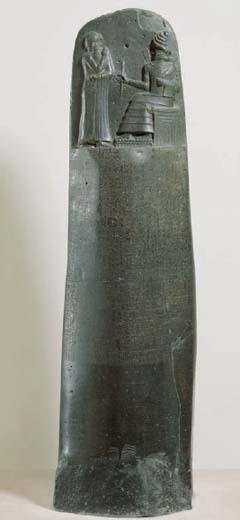Art of the Ancient World, C. 5000 B.c.e.–400 C.E.Art of the Ancient Near East |
What is the Stele of Hammurabi? |
Hammurabi was a Babylonian king who ruled over the lands of Mesopotamia during the second millennium B.C.E. He is famous for his code of laws, the earliest known legal code. The code itself is carved into a seven-foot stele, a large slab of black diorite, and in it Hammurabi declares that his code will “cause justice to prevail in the land and to destroy the wicked and the evil, that the strong might not oppress the weak nor the weak the strong” (as quoted in Stokstad 38).
At the top of the stele, above the written code, is a carving that depicts Hammurabi himself standing before the sun-god Shamash. Shamash, who was also the Babylonian god of justice, is seated in his throne and is surrounded by symbols of power. He rests his feet on a mountain top, wears a long, elaborate robe, and offers a rod and rope circle in his hands. Hammurabi’s arms are crossed respectfully in front of him, and he receives the laws as given to him by Shamash. The stele serves as a powerful marker of Hammurabi’s high status and represents the divine inspiration of his code.

The Code of Hammurabi (eighteenth century B.C.E.) was written in cuneiform, the first system of written language. At the top, Hammurabi is depicted standing with the Babylonian sun-god Shamash, also the god of justice.
